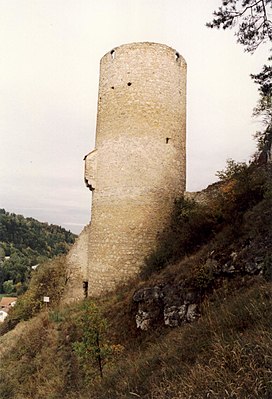Loch Loch (Eichhofen)
| Castle Loch | ||
|---|---|---|
|
South side of the keep (1990) |
||
| Creation time : | First mentioned in the 12th century | |
| Castle type : | Höhenburg, cave castle | |
| Conservation status: | Received or received substantial parts | |
| Place: | Nittendorf | |
| Geographical location | 49 ° 0 '54 " N , 11 ° 55' 44.5" E | |
|
|
||
The castle ruin Loch is a listed castle ruin in the district of Loch in the Bavarian market of Nittendorf and the landmark of Loch. It is the rare example of a cave castle in Bavaria, only in Stein an der Traun in Upper Bavaria there is another castle of this type.
history
The date of foundation of the small hill fort is not historically certain. Both the 12th and 14th centuries are considered by historians. The builders were the Rammelsteiners , lords of a nearby estate and ministerials of the Burgraves of Regensburg . They built the castle to protect a hammer mill .
When Sebastian von Rammelstein, the last male from Rammelstein, died in 1556, there were inheritance disputes over the castle and the property belonging to it. Sebastian had left the complex to his wife Margarethe in his will, but his nephew, Wolf Heinrich Sauerzapf, who was married to Sebastian's sister Magdalena, protested against it. The ensuing dispute was only settled in 1573 by a judgment that the Loch Castle awarded the Sauerzapfs .
In 1625 at the latest, his descendant Veit Philipp Sauerzapf relocated to neighboring Schönhofen , as the castle was too uncomfortable for him to live in. The buildings have been empty since then and have not been used any more. Gradual decline began.
After his death in 1714, Christoph von Sauerzapf bequeathed Loch Loch to the Charterhouse of Prüll in Regensburg. In the course of secularization , the facility fell to the Bavarian state and then came to the respective landowners of Eichhofen .
The last owners were Günther and Dietlinde von Braunbehrens, née Freiin von Werthern, and their descendant Ingeborg Schönharting, née Braunbehrens. These families continued to work for a long time to maintain the complex, but had to give up the property for financial reasons. They were deleted from the land register, since then the castle has been ownerless . The Free State of Bavaria, within whose borders the castle ruins are located, is responsible.
description
Loch Burg consisted of two large cave rooms with walls. This was followed by an extensive network of smaller adjoining rooms in the cave. The largest room with a floor plan of 12.5 by 7 meters was used as living space and was paneled with wood on the inside. It was heated by a fireplace that is still visible today. In this room, after the castle was abandoned, the ceiling partially broke through to the surface. Therefore, you can enter this cave area from the mountainside and from the mountainside. Brick walls are still present in this room with former doors. The cave has two floors, but the upper floor only has a small chamber. There were also other buildings outside the cave that were leaned against the rock face. The area in front of the cave was surrounded by a high circular wall and additionally protected by a kennel .
The placed directly in front of the cave, round keep French style is the only one still intact and highly visible building of the castle ruins. The approximately 22 meter high quarry stone tower has two meter thick walls on the ground floor. These taper to 50 centimeters over four storeys. Through its facilities with windows and garderobe , today, the medieval wooden abortion wood is present, it was relatively comfortably decorated and have a high input to enter. In 1989 it was restored.
literature
- Andreas Boos : Castles in the south of the Upper Palatinate . Universitätsverlag Regensburg, Regensburg 1998, ISBN 3-930480-03-4 , pp. 429-432.
- Ursula Pfistermeister : Castles of the Upper Palatinate . Verlag Friedrich Pustet, Regensburg 1974, ISBN 3-7917-0394-3 , p. 91.



